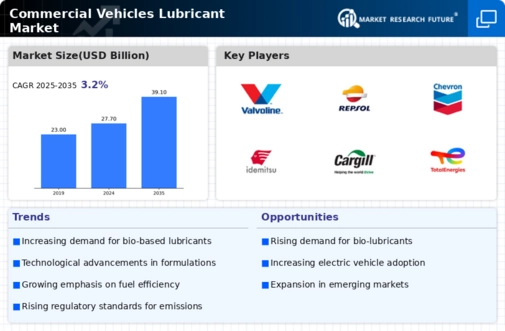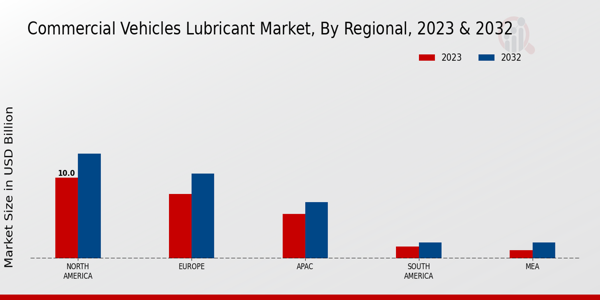Growth of Fleet Management Solutions
The rise of fleet management solutions is a pivotal driver for the Global Commercial Vehicles Lubricant Market Industry. As businesses increasingly adopt technology to monitor and optimize fleet operations, the demand for high-quality lubricants that support these systems is growing. Fleet managers are focusing on predictive maintenance strategies, which rely on advanced lubricants to ensure vehicle reliability and minimize downtime. This trend is expected to contribute to the market's growth, with a projected CAGR of 3.18% from 2025 to 2035. The integration of lubricants into fleet management practices highlights their critical role in enhancing operational efficiency and reducing costs.
Rising Demand for Commercial Vehicles
The Global Commercial Vehicles Lubricant Market Industry is experiencing a notable surge in demand for commercial vehicles, driven by the expansion of e-commerce and logistics sectors. This growth is reflected in the increasing number of delivery trucks and freight vehicles on the roads. As businesses seek to optimize their operations, the need for high-performance lubricants that enhance engine efficiency and reduce wear becomes paramount. The market is projected to reach 27.7 USD Billion in 2024, indicating a robust growth trajectory. This trend underscores the importance of quality lubricants in maintaining vehicle performance and longevity, thereby propelling the lubricant market forward.
Technological Advancements in Lubricants
Innovations in lubricant formulations are significantly influencing the Global Commercial Vehicles Lubricant Market Industry. The introduction of synthetic and semi-synthetic lubricants offers superior performance characteristics, such as improved thermal stability and reduced friction. These advancements not only enhance fuel efficiency but also extend the service life of engines, which is crucial for commercial vehicle operators. As manufacturers continue to invest in research and development, the availability of advanced lubricants is expected to increase. This trend aligns with the anticipated market growth, projected to reach 39.1 USD Billion by 2035, highlighting the critical role of technology in shaping the future of the lubricant industry.
Regulatory Compliance and Environmental Standards
The Global Commercial Vehicles Lubricant Market Industry is increasingly influenced by stringent regulatory frameworks aimed at reducing emissions and promoting environmental sustainability. Governments worldwide are implementing regulations that require the use of low-viscosity and eco-friendly lubricants in commercial vehicles. This shift not only helps in meeting compliance standards but also enhances fuel efficiency, thereby reducing operational costs for fleet operators. As a result, lubricant manufacturers are adapting their product lines to meet these evolving standards. The growing emphasis on sustainability is likely to drive market growth, as companies seek to align with regulatory requirements while maintaining performance.
Chart: Global Commercial Vehicles Lubricant Market Growth
This chart illustrates the projected growth trajectory of the Global Commercial Vehicles Lubricant Market Industry from 2024 to 2035. It highlights the anticipated increase in market value, reaching 27.7 USD Billion in 2024 and 39.1 USD Billion by 2035, with a CAGR of 3.18% for the period between 2025 and 2035. The visual representation of this data underscores the ongoing expansion and evolving dynamics within the lubricant market, reflecting the interplay of various market drivers.












